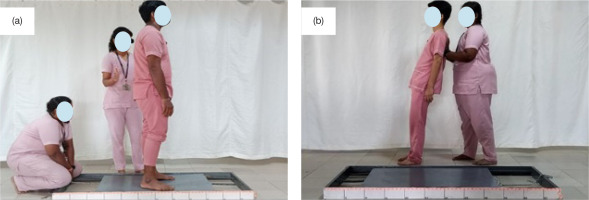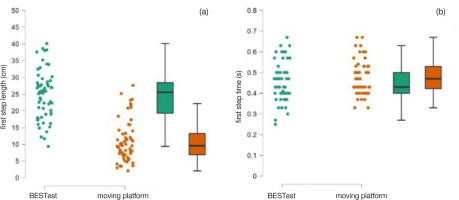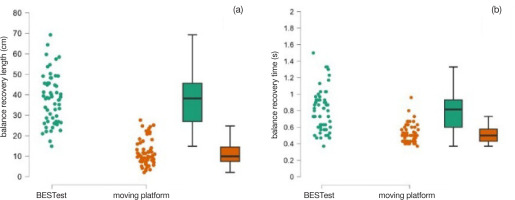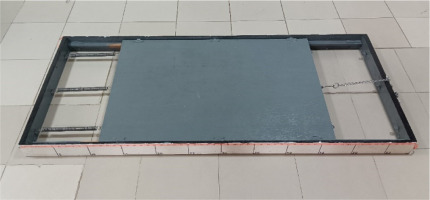Introduction
Reactive postural control refers to an individual’s ability to maintain an upright posture when unexpected external forces destabilise the body. This is achieved through the interaction of various sensorimotor systems, including the somatosensory, vestibular, visual, musculoskeletal and central systems [1]. in response to large perturbations that move the centre of mass beyond the limits of stability, reactive stepping is a common strategy used to create a new base of support [2]. The inability to perform a stepping reaction increases the risk of falls, making reactive stepping essential for fall prevention.
The loss of visual information, reduced muscle strength and stiffness in the hip and trunk muscles contribute to backwards balance impairment. Research suggests that backwards balance impairment is more prevalent in the elderly population, posing a potential threat of hip fractures and increased mortality rates [3]. Reactive backwards stepping is the typical response to a loss of balance in the posterior direction. Compared to forwards stepping reactions observed in both young and elderly adults, reactive backwards stepping exhibits a shorter reaction time, slower steps and reduced trunk backwards lean [4].
The most commonly used methods for assessing reactive stepping are cable pulls [5], surface translations [6, 7] and the Balance Evaluation Systems Test (BESTest) [8, 9]. The design of the test can influence the stepping response, depending on the type of step-provoking stimulus applied. Verniba et al. [10] demonstrated that perturbations from surface translations are more destabilising compared to shoulder-pull perturbations. This leads to a more rapid increase in perturbatory ankle torque and greater centre-of-mass motion before the onset of the postural reaction, making surface translations more effective in revealing the most efficient balance ability of an individual. The authors also caution that results from studies using different balance assessment paradigms should be interpreted carefully [10, 11]. When using the BESTest to evaluate reactive stepping strategies, its design allows for some anticipation of the stimulus, reducing its ability to assess true reactive stepping. it is preferable for the assessment method to elicit an optimal reactive stepping response that accurately reflects an individual’s ability to meet the challenges of real-life situations and prevent falls. We anticipate that a moving platform, inducing perturbations through surface translation, can elicit stepping responses more similar to real-life scenarios compared to the BESTest.
First step distance, first step duration, balance recovery time, balance recovery distance and the number of steps taken are common parameters assessed to understand the balance recovery response [12–14]. Comparing these parameters of backwards steps elicited by a moving platform and the BESTest can provide insights into the impact of test design on these parameters. This understanding can help in selecting the most appropriate testing method based on its capacity to elicit an optimal response. Consequently, we conducted this study to compare the characteristics of reactive backwards steps induced by the BESTest with those provoked by perturbations from a moving platform.
Subjects and methods
Healthy young adults aged 18 to 26 years were screened for inclusion in the study. Participants without limb length discrepancies or deformities in the lower limb or spine were included after providing informed consent to participate in the study. Subjects with a history of musculoskeletal injuries, neurological or cardiorespiratory conditions or recent surgical interventions that could affect the outcome of the study were excluded. Sixty young adults were included in the study. Participants were explicitly informed about the test procedures.
A moving platform was constructed for this study (Figure 1). The platform was made using outer rectangular metal frames with dimensions of 5 feet in length and 2.5 feet in breadth and an inner wooden movable platform with dimensions of 3 feet in length and 2 feet in breadth. one end of the moving platform was connected to the outer frame via 3 springs, each 0.5 feet in length, while the other end was attached to a spring weighing scale and a lock-release mechanism.
Participants were instructed that surface translation could happen at any moment, and they were required to respond appropriately in order to prevent a fall. Participants were not given prior experience on the moving platform to avoid a training effect. The therapist demonstrated the test procedures to the participant using another therapist on the platform as a test subject. during the testing procedure, the participant was instructed to stand barefoot on the moving wooden platform, facing the spring end. This position was chosen so that when perturbations occurred, the platform would move forwards relative to the participant’s standing direction, eliciting a backwards stepping reaction. A therapist stood at the side of the participant to prevent a fall during the test. Another therapist pulled the end of the moving platform connected to the spring weighing scale and locked the release mechanism. The mechanism was released without the participant’s knowledge in order to provoke a stepping reaction. The amount of force applied during the pull was measured using the spring weighing scale. Through a pilot study involving 15 young adults, it was determined that a minimum of 15% of the participant’s body weight was necessary to provoke a backwards step. This minimum force was, therefore, used in the current study. if a stepping response was not elicited, the force was increased by an additional 5%. Three trials of the backwards stepping response were video recorded for analysis (Figure 2a). Participants were not made to experience perturbations on the moving platform before the actual testing to avoid learning to respond on the moving platform.
Figure 2
(a) testing of backwards stepping using the moving platform, (b) testing of backwards stepping using the BESTest

During the provocation of backwards stepping in the BESTest, participants were instructed to stand upright, barefoot on the floor. They were instructed to make necessary postural reactions to prevent a fall when threatened with a fall during the test. A therapist positioned themselves behind the participant at a distance that allowed the participant to take a step backwards. The therapist placed both hands under the scapulae bilaterally and instructed the participant to lean backwards until the shoulders and hips were at the back of the heels. Support from the scapulae was released suddenly when the participant was in a relaxed state (Figure 2b). The backwards stepping responses were graded according to the BESTest grading system. Three trials of the backwards stepping response in this testing method were recorded on video.
The recorded video of backwards stepping was analysed using “TRACKER” software (version 6.1.3). The spatiotemporal parameters of backwards stepping, such as first step length, first step time, balance recovery length, balance recovery time and number of steps, were measured. The first step length is the distance calculated from the initial point of the heel of the stepping leg to the final point of the heel of the same leg in its first step. The first step time is the time period calculated from the initiation of movement on the stepping leg until the foot is placed on the ground in its first step. The balance recovery length is the distance calculated from the initial point of the heel of the stepping leg to the final point of the heel of the stepping leg, where no further leg movements are made for re-stabilisation. The balance recovery time is the time period calculated from the initiation of movement on the stepping leg until the final step taken for re-stabilisation.
The trial that showed the minimum values for first step length, first step time, balance recovery length and balance recovery time was selected from the three trials and tested for differences between the outcomes of the moving platform and BESTest methods. Stepping threshold (i.e., the percentage of body weight required for perturbation in the moving platform) was recorded to determine the minimum force required to elicit a response in participants of both the group. The side of the stepping leg and the number of steps taken by the participant during moving platform and BESTest perturbations were cross-tabulated to understand individual participant differences in these attributes.
Results
A total of 29 male and 31 female participants who met the inclusion criteria were selected for this study. The participants had an average age of 20.45 ± 0.08 years. The recorded height and weight measurements of the participants were 164.6 ± 0.05 cm and 60.42 ± 0.18 kg, respectively.
The first step length, balance recovery time and balance recovery length were shorter during backwards stepping induced by the moving platform compared to the BESTest. However, the first step time was similar in both assessment methods (Table 1, Figure 3, 4).
Table 1
Spatiotemporal characteristics of backwards stepping in moving platform and BESTest methods
Figure 3
Raindrop plot for (a) first step length (b) first step time during backwards stepping in the moving platform and BESTest methods

Figure 4
Raindrop plots of (a) balance recovery length and (b) balance recovery time following perturbations in BESTest and moving platform”

Approximately 50% of the participants required a pulling force equivalent to 15% of their body weight to induce perturbations on the moving platform. This was followed by 27% of participants who required a pulling force equivalent to 20% of their body weight (Table 2). Regarding the first backwards step taken, 58% of the participants used the same leg in both assessments, while others exhibited variations in their performance (Table 3). Ninety-two percent of the participants took a single backwards step to regain their balance on the moving platform, whereas only 35% of participants demonstrated a single backwards step in the BESTest (Table 4). Notably, 58% of participants who demonstrated multiple steps in the BESTest were able to recover balance with a single step on the moving platform.
Table 2
Distribution of the number of participants based on the percentage of body weight required for perturbation in moving platform methods
| Percentage of body weight | 10%* | 15%* | 20%* | 25%* |
|---|---|---|---|---|
| Number of participants | 8 | 31 | 16 | 5 |
Discussion
The study results show that the design of the assessment method can influence the characteristics of the backwards stepping response. Specifically, for moving platform perturbations, the first step length, balance recovery length and balance recovery time were smaller compared to the BESTest, with the exception of first step time. These findings suggest that the moving platform perturbation may elicit a more proficient backwards protective stepping response in individuals.
The first step length and balance recovery length were significantly larger in the BESTest compared to the moving platform. This observation aligns with the study by HsiaoWecksler et al. [8], which indicates that a greater release angle results in a longer protective stepping length. Notably, moving platform perturbations are administered in an upright position, whereas BESTest perturbations involve the lean-and-release method. As a result, the leaning motion in the BESTest leads to a longer step length compared to the response observed during the moving platform perturbations.
Among the four parameters examined, no statistically significant difference was found for first step time, although the value in BESTest was shorter than in the moving platform test. one possible explanation for the equally quicker first step in the BESTest could be attributed to the smaller margin of support during the perturbation, as explained by Verniba et al. [10]. Their findings suggest that a reduced margin of stability can affect the stepping response by increasing the velocity. in the BESTest, participants assume a backwards-leaning position, which is less stable, whereas, during moving platform perturbations, participants remain upright, providing greater stability. Consequently, the BESTest produces a smaller margin of stability, leading to increased perturbation velocity and potentially accounting for the faster first step response observed in this test. Fujimoto et al. [15] report that during a multiple-stepping response, the centre of mass moves as quickly as possible, resulting in a quicker first step compared to a single-step response. This may have influenced the faster first step time observed in the BESTest.
An examination of the characteristics of backwards stepping on the moving platform (Table 2) reveals that the force required to elicit a reactive step varied among the participants. Specifically, thirty participants (50%) required 15% of their body weight, followed by 16 participants who required 20% of their body weight to trigger a reactive step. This contrasts with the study by dePasquale et al. [16], which states that the stepping threshold of an individual has a cut-off value of 10% of total body weight in both the anteroposterior and mediolateral directions. This variation may be due to differences in the instrumentation used in the two studies.
The leg used to initiate the first step varied between the testing conditions. The observable effect of side dominance on the implementation of the first step was not evident in the results. in both methods, 20 participants (33.33%) used their right leg for the first step, while 15 participants (25%) used their left leg. Approximately 58.33% of participants demonstrated a preference for one leg when performing backwards stepping, yet the underlying reasons for this remain unclear. Nevertheless, existing literature on proactive balance activities that evaluated leg dominance suggests an absence of a discernible right/left dominance when performing coordinated balance activities [17, 18].
The number of steps taken to restore balance varied between the two testing methods. The ability to stabilise with a minimal number of steps could be considered an indicator of proficient postural reaction. in the moving platform method, 55 participants (91.67%) took a single step, whereas 5 participants (8.33%) took multiple steps to regain balance (Table 4). Conversely, in the BESTest, 39 participants (65%) took multiple steps, whereas 21 participants (35%) took a single step to regain balance. This indicates that BESTest perturbations predominantly elicit a multiple-step response. Notably, 35 participants (58.33%) who exhibited a single-step response on the moving platform displayed a multiple-step response in the BESTest. The variation in response can be ascribed to the spatial constraints of both testing methods. in the moving platform condition, participants likely attempted to restrict their response within the platform, despite the absence of explicit instructions to do so. This ability reflects their more optimal stepping response compared to the BESTest condition.
Limitations
The potential impact of the release angle in the BESTest could have been mitigated by standardising the release angle using an appropriate methodology. This standardisation process would help reduce any variability in stepping responses caused by intra-rater differences in the release angle.
Conclusions
The characteristics of backwards stepping were influenced by the assessment method. The moving platform elicited a shorter step length, quicker step time and a reduced number of steps compared to the BESTest, with the exception of the first step time.
Clinical implications
The evaluation of reactive backwards stepping is crucial for assessing an individual’s ability to maintain stability while moving backwards. External destabilising perturbations that push an individual backwards can lead to serious morbidity in the elderly, particularly due to the lack of visual information. The current study suggests that the chosen assessment method can impact reactive stepping responses. it is recommended that the method used should elicit the individual’s optimal reactive ability. Utilising a method that replicates real-life situations involving balance threats would be beneficial in understanding an individual’s proficiency in performing backwards stepping. Among the methods used in this study, it was concluded that the moving platform may be the most effective approach for evaluating backwards stepping abilities.


